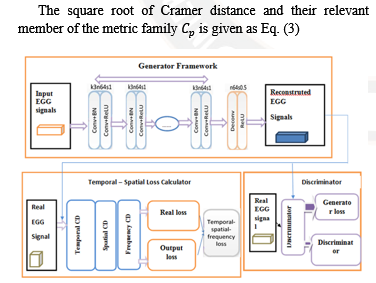Improving Deep Learning for Seizure Detection using GAN with Cramer Distance and a Temporal-Spatial-Frequency Loss Function
Main Article Content
Abstract
The signals of EEG are analyzed in the identification of seizure and diagnosis of epilepsy. The visual examination process of EEG data by skilled physician is huge time-utilization and the judgemental process is complicated, which may vary or show inconsistency among the physician. Hence, an automatic process in diagnosis and detection was initiated by the Deep Learning (DL) approaches. Time Aware Convolutional Neural Network with Recurrent Neural Network (TA-CNN-RNN) was one among them. Deep neural networks trained on large labels performed well on many supervised learning tasks. Creating such massive databases takes time, resources, and effort. In many circumstances, such resources are unavailable, restricting DL adoption and use. In this manuscript, Generative Adversarial Networks with the Cramer distance (CGAN) is proposed to generate an accurate data for each lable. A spatiotemporal error factor is introduced to differentiate actual and genetrated data. The discriminator is learned to differentiate the created data from the actual ones, while the generator is learned to create counterfeit data, which are not estimated as false by the discriminator. The classical GANs have a complex learning because of the nonlinear and non-stationary features of EEG data which is solved by Carmer Distance in the proposed method. Finally, the sample generated by CGAN is given as input for the Time Aware Convolutional Neural Network with Recurrent Neural Network (TA-CNN-RNN) classifier to investigate experimental seizure Prediction outcome of the proposed CGAN. From the investigational outcomes, the proposed CGAN- TA-CNN-RNN model attained classification accuracy of 94.6%, 94.8% and 95.2% on CHB-MIT-EEG, Bonn-iEEG and VIRGO-EEG than other existing EEG classification schemes and also provides great potentials in real-time applications.
Article Details
References
R. S. Fisher, W. V. E. Boas, W. Blume, C. Elger, P. Genton, P. Lee and J. Engel Jr, “Epileptic seizures and epilepsy: definitions proposed by the International League Against Epilepsy (ILAE) and the International Bureau for Epilepsy (IBE),” Epilepsia, vol. 46, no. 4, pp. 470-472, 2015, doi: 10.1111/j.0013-9580.2005.66104.x.
H. Takahashi, S. Takahashi, R. Kanzaki and K. Kawai, “State-dependent precursors of seizures in correlation-based functional networks of electrocorticograms of patients with temporal lobe epilepsy,” Neurological Sciences, vol. 33, no. 6, pp.1355-1364, 2012, doi: 10.1007/s10072-012-0949-5
T. Tzallas, M. G. Tsipouras, D. G. Tsalikakis, E. C. Karvounis, L. Astrakas, S., Konitsiotis and M. Tzaphlidou, “Automated epileptic seizure detection methods: a review study,” Epilepsy-histological, electroencephalographic and psychological aspects, pp.75-98, 2012, doi: 10.5772/31597
A. Sharmila, S. Aman Raj, P. Shashank and P. Mahalakshmi, “Epileptic seizure detection using DWT-based approximate entropy, Shannon entropy and support vector machine: a case study,” Journal of medical engineering & technology, vol. 42, no. 1, pp. 1-8, 2018, doi: 10.1080/03091902.2017.1394389
P. M. Shanir, K. A. Khan, Y. U. Khan, O. Farooq and H, Adeli, “Automatic seizure detection based on morphological features using one-dimensional local binary pattern on long-term EEG,” Clinical EEG and neuroscience, vol. 49, no. 5, pp. 351-362, 2018, doi: 10.1177/1550059417744890.
A. R. Hassan, and A. Subasi, “Automatic identification of epileptic seizures from EEG signals using linear programming boosting,” computer methods and programs in biomedicine, vol. 136, pp. 65-77, 2016, doi:10.1016/j.cmpb.2016.08.013
Y. S Park, G. R. Cosgrove, J. R. Madsen, E. N. Eskandar, L. R. Hochberg, S. S. Cash and W. Truccolo, “Early detection of human epileptic seizures based on intracortical microelectrode array signals,” IEEE Transactions on Biomedical Engineering, vol. 67, no. 3, pp. 817-831, 2019, doi: 10.1109/TBME.2019.2921448.
K. Belwafi, S. Gannouni and H. Aboalsamh, “An effective zeros-time windowing strategy to detect sensorimotor rhythms related to motor imagery EEG signals,” IEEE Access, vol. 8, pp. 152669-152679, 2020, doi: 10.1109/access.2020.3017888
S. Chen, X. Zhang, L. Chen and Z. Yang, “Automatic diagnosis of epileptic seizure in electroencephalography signals using nonlinear dynamics features,” IEEE Access, vol. 7, pp. 61046-61056, 2019, doi: 10.1109/ACCESS.2019.2915610
M. C. Guerrero, J. S. Parada, and H. E. Espitia, Principal Components Analysis of EEG Signals for Epileptic Patient Identification,” Computation, vol. 9, no. 12, 133, 2021, doi: 10.3390/computation9120133.
L. Hussain, “Detecting epileptic seizure with different feature extracting strategies using robust machine learning classification techniques by applying advance parameter optimization approach,” Cognitive neurodynamics, vol. 12, no. 3, pp. 271-294, 2018, doi: 10.1007/s11571-018-9477-1.
R. Sharma and R. B. Pachori, “Classification of epileptic seizures in EEG signals based on phase space representation of intrinsic mode functions,” Expert Systems with Applications, vol. 42, no. 3, pp. 1106-1117, 2015, doi: 10.1016/j.eswa.2014.08.030.
A. Malekzadeh, A. Zare, M. Yaghoobi, H. R. Kobravi and R, Alizadehsani, “Epileptic seizures detection in EEG signals using fusion handcrafted and deep learning features,” Sensors, vol. 21, no. 22, pp. 7710, 2021, doi: 10.1016/j.iot.2019.03.002.
R. M. Khati and R. Ingle, Feature extraction for epileptic seizure detection using machine learning. Current medicine research and practice, vol. 10, no. 6, pp. 266, 2020, doi: 10.4103/cmrp.cmrp_52_20.
H. T. Shiao, V. Cherkassky, J. Lee, B. Veber, E. E. Patterson, B. H. Brinkmann and G. A. Worrell, “SVM-based system for prediction of epileptic seizures from iEEG signal,” IEEE Transactions on Biomedical Engineering, vol. 64, no. 5, pp. 1011-1022, 2016, doi: 10.1109/tbme.2016.2586475.
Y. H. Liu, L. Chen, X. W. Li, Y. C. Wu, S. Liu, J. J. Wang, ..., and Y. Liu, “Epilepsy detection with artificial neural network based on as-fabricated neuromorphic chip platform,” AIP Advances, vol. 12, no. 3, pp. 035106, 2022, doi; 10.1063/5.0075761.
R. G. Thangarajoo, M. B. I. Reaz, G. Srivastava, F. Haque, S. H. M. Ali, A. A. A. Bakar and M. A. S. Bhuiyan, “Machine learning-based epileptic seizure detection methods using wavelet and EMD-based decomposition techniques: A review,” Sensors, vol. 21, no. 24, pp. 8485, 2021.
E. B. Assi, D. K. Nguyen, S. Rihana and M. Sawan, “Towards accurate prediction of epileptic seizures: A review,” Biomedical Signal Processing and Control, vol. 34, pp. 144-157, 2017, doi: 10.1016/j.bspc.2017.02.001.
A. Shoeibi, M. Khodatars, N. Ghassemi, M. Jafari, P. Moridian, R. Alizadehsani, .., and U. R. Acharya, “Epileptic seizures detection using deep learning techniques: A review,” International Journal of Environmental Research and Public Health, vol. 18, no. 11, pp. 5780, 2021, doi: 10.3390/ijerph18115780.
A. Abdelhameed and M. Bayoumi, “A deep learning approach for automatic seizure detection in children with epilepsy,” Frontiers in Computational Neuroscience, vol. 15, pp. 650050, doi: 10.3389/fncom.2021.650050.
S. T. Jaafar and M. Mohammadi, “Epileptic seizure detection using deep learning approach,” UHD Journal of Science and Technology (UHDJST), vol. 3, no. 2, pp. 41-50, 2019, doi: 10.21928/uhdjst.v3n2y2019.pp41-50.
R. Hussein, H. Palangi, R. K. Ward and Z. J. Wang, “Optimized deep neural network architecture for robust detection of epileptic seizures using EEG signals,” Clinical Neurophysiology, vol. 130, no. 1, pp. 25-37, 2019, doi: 10.1016/j.clinph.2018.10.010.
N. A. Samee, N. F. Mahmoud, E. A. Aldhahri, A. Rafiq, M. S. A. Muthanna and I. Ahmad, “RNN and BiLSTM Fusion for Accurate Automatic Epileptic Seizure Diagnosis Using EEG Signals. Life, vol. 12, no. 12, pp. 1946, 2022, doi: 10.3390/life12121946.
M. Zhou, C. Tian, R. Cao, B. Wang, Y. Niu, T. Hu,..., and J. Xiang, “Epileptic seizure detection based on EEG signals and CNN,” Frontiers in neuroinformatics, vol. 12, pp. 1-14, 2018, doi: 10.3389/fninf.2018.00095.
Irwansyah, E. ., Young, H. ., & Gunawan, A. A. S. . (2023). Multi Disaster Building Damage Assessment with Deep Learning using Satellite Imagery Data. International Journal of Intelligent Systems and Applications in Engineering, 11(1), 122–131. Retrieved from https://ijisae.org/index.php/IJISAE/article/view/2450.
P. Indurani and B. A. Firdaus Begam.” Prediction of Seizure in the EEG Signal with Time Aware Recurrent Neural Network,” Revue d'Intelligence Artificielle, vol. 36, no. 5, pp. 717-724, 2022, doi: 10.18280/ria.360508.
X. Yi, E. Walia and P. Babyn, “Generative adversarial network in medical imaging: A review,” Medical image analysis, vol, 58, pp. 101552, 2019, doi: 10.1016/j.media.2019.101552.
M. G. Bellemare and I. Danihelka, W. Dabney, S. Mohamed, B. Lakshminarayanan, S. Hoyer and R. Munos, “The cramer distance as a solution to biased wasserstein gradients,” arXiv preprint arXiv:1705.10743, May, 2017, https://doi.org/10.48550/arXiv.1705.10743
I. Ullah, M. Hussain, H. Aboalsamh, “An automated system for epilepsy detection using EEG brain signals based on deep learning approach”, Expert Systems with Applications, vol. 107, 2018, pp. 61-71, doi: 10.1016/j.eswa.2018.04.021
Ö. Türk and M. S. Özerdem, “Epilepsy detection by using scalogram based convolutional neural network from EEG signals,” Brain sciences, vol. 9, no. 5, pp. 115, May. 2019, doi: 10.3390/brainsci9050115.
F. Forooghifar, A. Aminifar and D. Atienza, “Resource-aware distributed epilepsy monitoring using self-awareness from edge to cloud,” IEEE Transactions on Biomedical Circuits and Systems, vol.13, no. 6, pp. 1338-1350, doi: 10.1109/TBCAS.2019.295122
R. Akut, “Wavelet based deep learning approach for epilepsy detection,” Health information science and systems, vol. 7, no. 1, pp. 1-9, 2019, doi: 10.1007/s13755-019-0069-1.
H. S. Chiang, M. Y., Chen and Y. J. Huang, “Wavelet-based EEG processing for epilepsy detection using fuzzy entropy and associative petri net,” IEEE Access, vol. 7, pp. 103255-103262, 2019, doi.10.1109/ACCESS.2019.2929266.
M. Sharma, S. Shahm and P. V. Achuth, “A novel approach for epilepsy detection using time–frequency localized bi-orthogonal wavelet filter,” Journal of Mechanics in Medicine and Biology, vol. 19, no, 01, pp. 1940007, 2019, doi.org/10.1142/S0219519419400074.
G. Andrzejak, K. Schindler, and C. Rummel, “Nonrandomness, nonlinear dependence, and nonstationarity of electroencephalographic recordings from epilepsy patients,'' Phys. Rev. E, Stat. Phys. Plasmas Fluids Relat.Interdiscip. Top., vol. 86, no. 4, pp. 046206, Oct. 2012, doi: 10.1103.
http://epileptologiebonn.de/cms/upload/workgroup/lehnertz/eegdata.html
https://ieee-dataport.org/documents/eeg-datasetepileptic-seizure- patients#files

